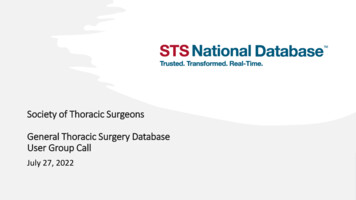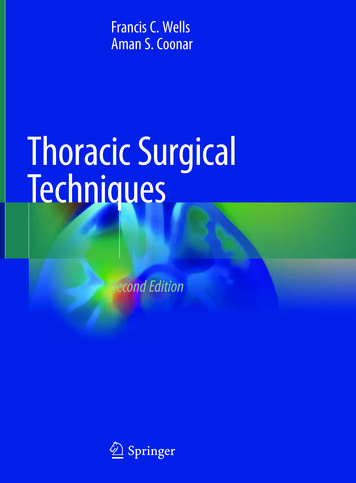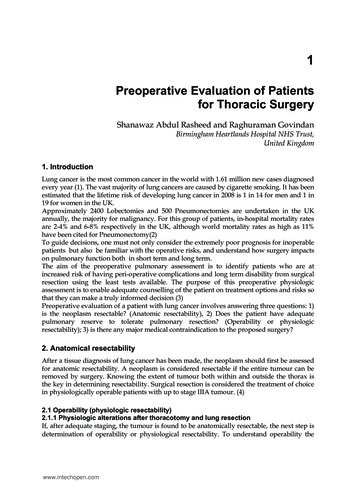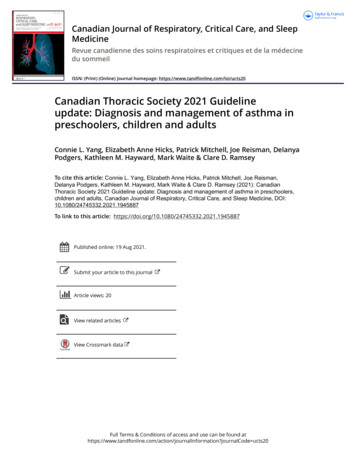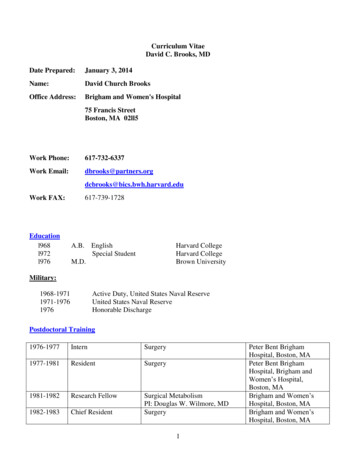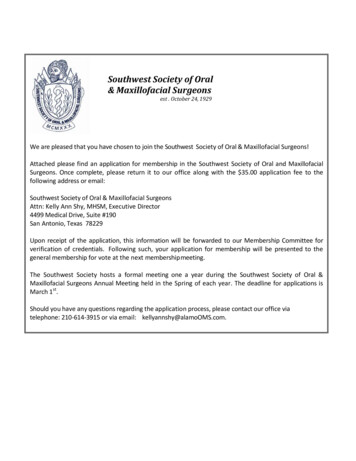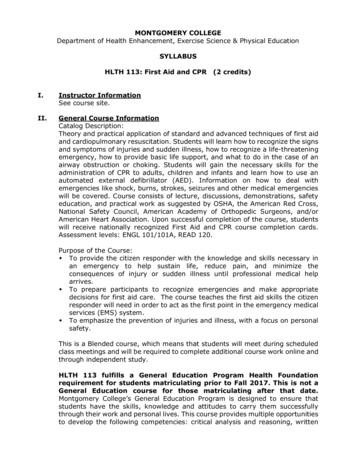
Transcription
REPORT FROM STS WORKFORCE ON EVIDENCE BASED SURGERYThe Society of Thoracic Surgeons PracticeGuideline on the Prophylaxis and Management ofAtrial Fibrillation Associated With GeneralThoracic Surgery: Executive SummaryHiran C. Fernando, MD, Michael T. Jaklitsch, MD, Garrett L. Walsh, MD,James E. Tisdale, PhD, Charles D. Bridges, MD, ScD, John D. Mitchell, MD, andJoseph B. Shrager, MDDepartment of Cardiothoracic Surgery, Boston University School of Medicine, Boston Medical Center, Boston, Massachusetts; Divisionof Thoracic Surgery, Harvard Medical School, Brigham and Women’s Hospital, Boston, Massachusetts; Department of Thoracic andCardiovascular Surgery, University of Texas MD Anderson Cancer Center, Houston, Texas; Department of Pharmacy Practice, Collegeof Pharmacy, Purdue University, and Division of Clinical Pharmacology, School of Medicine, Indiana University, Indianapolis, Indiana;Division of Cardiovascular Surgery, University of Pennsylvania School of Medicine, Philadelphia, Pennsylvania; Division ofCardiothoracic Surgery, University of Colorado School of Medicine, Aurora, Colorado; and Division of Thoracic Surgery, Department ofCardiothoracic Surgery, Stanford University School of Medicine, Stanford, California, and the VA Palo Alto Health Care System, PaloAlto, CaliforniaAREPORTtrial fibrillation (AF) occurs in between 12% and 44%of patients after pulmonary and esophageal surgery. Its occurrence is associated with increased pulmonary complications, increased length of stay, and increased mortality [1, 2]. Although numerous articles havebeen written on postoperative AF, specific recommendations for the prophylaxis and treatment of AF related togeneral thoracic surgery (GTS) do not exist. Therefore,The Society of Thoracic Surgeons (STS) Workforce onEvidence Based Surgery formed a taskforce to derivepractice recommendations from the literature.What follows is an executive summary of the fullguideline available at practice-credentialing-guidelines. Thefull guideline includes the complete references and detailedanalysis that fully supports the recommendations listed here.MethodsTaskforce members reviewed all identifiable publishedreports related to the prophylaxis and management of AFThe Society of Thoracic Surgeons Clinical Practice Guidelines are intended to assist physicians and other health care providers in clinicaldecision making by describing a range of generally acceptable approachesfor the diagnosis, management, or prevention of specific diseases or conditions. These guidelines should not be considered inclusive of all propermethods of care or exclusive of other methods of care reasonably directed atobtaining the same results. Moreover, these guidelines are subject to changeover time, without notice. The ultimate judgment regarding the care of aparticular patient must be made by the physician in light of the individualcircumstances presented by the patient.For the full text of this and other STS Practice Guidelines, visit -practice-credentialingguidelines at the official STS Web site (www.sts.org).Address correspondence to Dr Shrager, Department of CardiothoracicSurgery, Division of Thoracic Surgery, Stanford University School ofMedicine, 300 Pasteur Dr, Falk Building, 2nd Flr, Stanford, CA 943055407; e-mail: shrager@stanford.edu. 2011 by The Society of Thoracic SurgeonsPublished by Elsevier Incafter GTS as well as selected reports related to medicalAF and AF after cardiac and general surgical procedures.Publications for review were selected to inform recommendations in three areas: (1) prophylaxis, (2) treatment,and (3) anticoagulation. Levels of evidence were assignedto each publication, and recommendations were maderegarding each intervention using the American College of Cardiology/American Heart Association guidelinemethodology. The document was reviewed and approvedaccording to the “STS Approval Process for PracticeGuidelines.”Evidence-based guidelines must not be viewed as absolutes. Guidelines are intended to assist health care providers in decision-making by providing a range of acceptableapproaches for the management of specific conditions. Theultimate judgment regarding care of a particular patientunder specific circumstances must be made by the provider. There are certainly circumstances in which management that falls outside of these guidelines will beappropriate.Etiology and Risk FactorsRisk factors for postoperative AF include male sex, increasing age, magnitude of lung resected, magnitude ofesophagus resection, history of congestive heart failure,concomitant lung disease, preoperative episodes of AF,length of procedure [3–15], and procedures associatedwith pericardial inflammation, especially dissectionaround the atria [12, 16]. Reproducibly, the highest ratesof postoperative AF occur after pneumonectomies, extrapleural pneumonectomies, and adult lung transplants[17, 18]. After minimally invasive thoracic surgical procedures, the incidence of AF has been as low as 0.6% [19]. Inone study, 4 of 110 thoracoscopic lobectomy patients(3.6%) had AF [20]. Atrial fibrillation can also developpostoperatively secondary to a wide variety of medicalAnn Thorac Surg 2011;92:1144 –52 0003-4975/ 36.00doi:10.1016/j.athoracsur.2011.06.104
REPORT FROM STS WORKFORCE ON EVIDENCE BASED SURGERYconditions including hyperthyroidism, pulmonary emboli, pneumonia, or pericarditis.The onset of AF occurs most commonly on postoperative days 2 and 3 [1, 7, 21, 22]. The risk of arrhythmiasdecreases substantially over the first postoperativemonth, with nearly all patients reverting to preoperativerisk of AF by 6 weeks after coronary surgery, regardlessof treatment [23].Pharmacologic Prophylaxis of PostoperativeAtrial FibrillationClass I recommendation: Patients taking -blockers before GTS should have -blockade continued (at reduceddose if epidural analgesia is used) in the postoperativeperiod. (Level of evidence B)Class IIa recommendation: Diltiazem prophylaxis is reasonable in most patients undergoing major pulmonaryresection who are not taking a -blocker preoperatively.As with -blockers, hypotension may develop in somepatients receiving diltiazem prophylaxis, and dose reduction or other pressure-elevating therapies may be required. (Level of evidence B)Class IIa recommendation: Amiodarone prophylaxis is reasonable to reduce the incidence of atrial fibrillation afterGTS (excluding pneumonectomy), according to strict dosing regimens. For patients undergoing pulmonary lobectomy, the recommended dose is 1,050 mg by continuousinfusion over the first 24 hours after surgery (43.75 mg/h),followed by 400 mg orally twice daily for 6 days. Forpatients undergoing esophagectomy, the recommendeddose is continuous intravenous (IV) infusion at a rate of43.75 mg/h (1,050 mg daily) for 4 days. (Level of evidence B)Class III recommendation: Amiodarone is not recommended, outside of clinical studies, for patients undergoingpneumonectomy, until additional data addressing its potential toxicity in this setting are available. (Level of evidence B)Class IIa recommendation: Magnesium supplementationis reasonable to augment the prophylactic effects of othermedications. (Level of evidence B)Class IIb recommendation: It may be reasonable toinitiate new -blockers for prophylaxis against postoperative AF after GTS, but their use is more limited byside effects than diltiazem and thus less broadly applicable. (Level of evidence B)Class III recommendation: Flecainide is not recommended for prophylaxis of postoperative atrial fibrillation after GTS. (Level of evidence B)Class III recommendation: Digitalis should not be usedas a prophylactic agent against atrial fibrillation afterGTS. (Level of evidence A)FERNANDO ET ALSTS AF GUIDELINE1145Given the morbidity, mortality, and costs associatedwith postoperative AF, it would be beneficial to preventit, if that is possible, with an agent that incurs minimaladverse effects.In a meta-analysis of randomized controlled studies ofAF prophylaxis in GTS, Sedrakyan and colleagues [24]included 11 studies [25–35], and we are aware of tworandomized studies published since that time [36, 37].There have been three trials using digitalis [26, 28, 31],five trials with calcium-channel blockers [25, 26, 32, 34,35], two trials of prophylactic -blockers [27, 29], threetrials of amiodarone [34, 36, 37], and single trials offlecainide [30] and magnesium [33]. These trials collectively include more than 1,300 participants.The recommendation to avoid abrupt -blocker withdrawal is extrapolated from convincing data in the cardiac surgery literature attributing postoperative AF to apropranolol withdrawal syndrome [38]. A meta-analysisof randomized studies of AF prophylaxis clearly demonstrated elevated AF rates in patients whose -blockerswere withdrawn [39].Because GTS patients with epidural analgesia tend tobe mildly hypotensive, we recommend that preoperative -blockers be restarted postoperatively at one half thepreoperative dose, with “hold parameters.” The dose canthen be gradually increased as tolerated.For patients who were not taking -blocking medication preoperatively, the most broadly effective and safedrug prophylaxis for AF after GTS is diltiazem. Fiverandomized, double-blinded controlled trials have compared the efficacy of calcium-channel blockers to controlin the prophylaxis of postoperative AF after GTS (Table1) [25, 26, 32, 34, 35]. In these studies, the incidence of AFis reduced by approximately one half: 10.6% versus 21.5%(relative risk 0.50; 95% confidence interval: 0.34 to 0.73)[24]. Because diltiazem is associated with a far lower rateof hypotension than verapamil, diltiazem is the recommended calcium-blocking agent. Although the only placebo-controlled study of diltiazem for prevention of AFafter GTS administered it with an IV loading dose and24-hour infusion, only then followed by oral therapy, it maybe reasonable to administer prophylactic diltiazem orallyalone. Oral diltiazem begun in the recovery room is areasonable approach after lung resection. A reasonabledose is 30 to 60 mg every 6 hours, depending upon apatient’s body mass, age, and other factors. As with -blockers, diltiazem orders should include “holdparameters.”Prophylactic amiodarone is a reasonable alternative todiltiazem, but it should be used in limited doses andshould likely be avoided for certain patients. Prophylacticamiodarone significantly reduces the incidence of AFafter cardiac [39], pulmonary [34, 36], and esophageal [37]surgery. Among lung resection patients, the incidence ofAF was reduced by amiodarone from 21.9% to 3.1% inone study [34] and from 32.3% to 13.8% in the other studyversus placebo [36]. However, the first of these studies,which used a higher dose of the drug, was terminatedearly because of an incidence of acute respiratory distresssyndrome (ARDS) of 9.4% in those receiving amiodaroneREPORTAnn Thorac Surg2011;92:1144 –52
1146REPORT FROM STS WORKFORCE ON EVIDENCE BASED SURGERYSTS AF GUIDELINEFERNANDO ET ALAnn Thorac Surg2011;92:1144 –52Table 1. Randomized Trials of Calcium Channel Blocker Prophylaxis of Atrial Fibrillation (AF) in Pulmonary ResectionPatientsaAuthors [Reference], YearDrugLindgren et al [32], 1991IV followed by oral verapamilVan Miegham et al [34], 1994IV verapamilVan Miegham et al [35], 1996IV verapamilAmar et al [26], 1997IV followed by oral diltiazemAmar et al [25], 2000IV followed by oral DiltiazemaAF Rate, TreatedVersus Control0% versus 31%(p 0.05)0% versus 22%(p NR)8% versus 15%(p 0.05)14% versus 31%(p 0.035)15% versus 25%(p 0.03)SubjectsLung ctomyPneumonectomy“High risk” lobectomy/pneumonectomyAll studies are versus placebo, except Amar 1997, which is versus digoxin.IV intravenous;NR not reported.REPORT(versus 0% in the placebo group). Among pneumonectomy patients, the ARDS rate was 27%.Amiodarone-induced pulmonary toxicity appears tooccur not only after chronic administration, but alsooccasionally after brief periods of IV administration onthe order of days. Acute pulmonary toxicity related toamiodarone appears to be most common perioperatively.That may be because intraoperative and perioperativehigh inspired oxygen concentrations potentiate the freeradicals that may be etiologic. In one series, 3 of 8patients had ARDS after cardiac surgery after preoperative high-dose IV amiodarone therapy (1,200 mg for 7days), and ARDS developed in 6 of 11 patients who werereceiving long-term amiodarone therapy before cardiacsurgery [40]. In another series including various operations, 4 of 33 patients receiving prolonged preoperativeamiodarone therapy had postoperative ARDS [41]. Preexisting pulmonary disease is associated with a higherrisk of diagnosed amiodarone pulmonary toxicity [42].Conversely, in the study by Tisdale and colleagues [36]of amiodarone prophylaxis after lung resection, and intheir study of amiodarone prophylaxis after esophagealresection [37] (both of which used lower doses of amiodarone), no increased pulmonary toxicity was observed.The pulmonary resection series included 65 patients inthe experimental arm, 25% of whom underwent pneumonectomy. It appears likely that amiodarone at thelower dose used in these studies represents safe andeffective AF prophylaxis. But given that this has beendemonstrated in only a single study in the lung resectionpopulation, and given the evidence of pulmonary toxicityrelated to perioperative use of amiodarone at higherdoses—particularly in patients undergoing pneumonectomy, patients with chronic obstructive pulmonary disease (COPD), and theoretically, patients requiring highlevels of inspired oxygen or mechanical ventilation—webelieve that prophylactic amiodarone use must be considered and planned carefully. It should likely be avoidedfor patients with significant preexisting lung disease,patients who remain intubated or require high inspiredoxygen concentrations, and patients who have undergone pneumonectomy. It should also likely not be startedpreoperatively. It may well be proven ultimately thatthere is no pulmonary toxicity related to amiodaroneusing the dosing regimens employed by Tisdale andcoworkers, but until additional data are available on thisissue, it is prudent, outside of studies, to limit the use ofamiodarone for pulmonary resection patients to thoseundergoing lobectomy.Newly initiated -blockade is clearly effective prophylaxis against AF after cardiac surgery [39]. In the GTSpopulation, however, only two randomized controlledtrials of this approach have been published [27, 29].Although this treatment does reduce AF to a similardegree as calcium-channel blockers, morbidity is substantially higher, with a 49% incidence of hypotension, a25% incidence of bradycardia, and a 14.1% incidence ofpulmonary edema.An additional, important concern with newly initiated -blockers is the small but real risk of precipitatingbronchospasm with -blockade in COPD patients. (Fordetails on this risk, which is more of a concern withpatients who are -blocker naïve, see the Treatment ofPostoperative Atrial Fibrillation section.)In the cardiac surgery population, magnesium supplementation reduces postoperative AF [43]. The only prospective randomized trial involving GTS patients alsodemonstrated a significant reduction in the incidence ofAF without substantial adverse events [33].Although it is a good choice as therapy for postoperative AF in patients without structural heart disease (seeTreatment section), experience with flecainide as a prophylactic agent has been limited and mixed. Oral flecainide has not been studied in this setting, and the smalltrials using IV flecainide (which has limited availability)report rates of hypotension as high as 57% [30]. Furthermore, that the use of flecainide would need to be strictlylimited to patients without structural heart disease substantially limits its applicability [44]. Three randomizedstudies have demonstrated that digitalis prophylaxis ac-
REPORT FROM STS WORKFORCE ON EVIDENCE BASED SURGERYtually increases the incidence of postoperative AF versusplacebo after GTS [26, 28, 31].Pharmacologic Treatment of PostoperativeAtrial FibrillationRate Control Versus Rhythm ControlClass I recommendation: Patients with hemodynamicallyunstable postoperative AF should be electrically cardioverted. (Level of evidence C)Class I recommendation: Patients with hemodynamicallystable but symptomatically intolerable AF should bechemically cardioverted, with electrical cardioversion ifchemical cardioversion fails. (Level of evidence C)Class I recommendation: Patients with hemodynamicallystable and symptomatically acceptable postoperative AFshould receive a trial of rate control lasting approximately 24 hours. (Level of evidence B)Class IIa recommendation: For patients with hemodynamically stable, continuous or recurrent, paroxysmalpostoperative AF ongoing more than 24 hours afterinitiation of rate control, it is reasonable to attemptchemical cardioversion. (Level of evidence C)Class IIb recommendation: Patients with hemodynamically stable, continuous or recurrent, paroxysmal postoperative AF ongoing after adequate levels of a chemicalcardioverting agent have been achieved may be considered for an attempt at electrical cardioversion. (Level ofevidence C)A substantial number of patients will, despite prophylaxis, have AF after GTS. If there is associated hemodynamic instability, electrical cardioversion should be carried out urgently. Most patients, however, will havehemodynamically stable AF. For patients who, despitehemodynamic stability, find the symptoms of AF intolerable even with rate control, an early attempt at chemicalcardioversion is reasonable. If that fails to convert thepatient to sinus rhythm after the initial load, then electrical cardioversion is reasonable.The vast majority of patients have AF that createsneither hemodynamic instability nor intolerable symptoms. These patients are the focus of our recommendations. Since new-onset postoperative AF is often transientand self-limited, and since rate control agents are generally safer than agents designed to achieve cardioversion,it is appropriate to treat stable patients initially with ratecontrol agents alone. One study involving 200 lung resection patients reported that 98% of AF resolved within1 day of hospital discharge with rate control alone [4].Seventy-three percent of patients with AF after aorticsurgery in one study had converted at a mean of 48 hours[45]. Two small randomized studies compared rate control and cardioversion strategies for AF after cardiacsurgery [46, 47], and neither demonstrated a significantFERNANDO ET ALSTS AF GUIDELINE1147difference in ultimate outcome between the twoapproaches.Choice of Agent: Rate Control DrugsClass I recommendation: A selective 1-blocking agent isrecommended as the initial drug for rate control in theabsence of moderate-severe chronic obstructive pulmonarydisease or active bronchospasm. (Level of evidence B)Class I recommendation: Diltiazem should be the firstagent used in the presence of moderate-severe chronicobstructive pulmonary disease or active bronchospasm.(Level of evidence B)Class III recommendation: Digoxin as a single agentshould not be used for rate control, although it may beeffective in combination with a 1-blocker or diltiazem.(Level of evidence A)Diltiazem has been proven to be more effective thandigoxin in the treatment of AF after coronary arterybypass surgery [48], and -blockade has been proven tobe more effective than either calcium-blockade or digoxinin rate control of AF in the medical population [49].Beta-blockers also appear to more effective than calciumblockers in converting AF to sinus rhythm after noncardiac surgery [50]. No studies have compared these drugsafter GTS specifically. Given its shorter duration of action,its relative 1-receptor specificity, and its availability inintravenous form, metoprolol is probably the appropriateinitial agent.The potential concern with the use of -blockers forCOPD patients, who constitute a large proportion of thepatients undergoing GTS, is that nonspecific blockademay precipitate bronchospasm. Although that occurswith some frequency with nonspecific -blockers such aspropranolol, 1-specific agents such as metoprolol have avery low risk of inducing clinically significant bronchospasm [51, 52], although they may increase airway hyperresponsiveness [53]. A selective 1-antagonist thus seemsa reasonable first-line rate control agent for all patientsbut those with active bronchospasm or more than moderate COPD. These latter patients should be rate controlled with diltiazem. If diltiazem is being used for AFprophylaxis, it is reasonable to either add metoprolol orincrease the diltiazem dose if postoperative AF develops.Choice of Agent: Rhythm Control(Antiarrhythmic) DrugsClass IIa recommendation: When chemical cardioversion is employed in the setting of continuous orrecurrent paroxysmal postoperative AF, the most reasonable initial drugs are intravenous followed by oralamiodarone or oral flecainide. Several other agents canbe considered when these are contraindicated. (Levelof evidence B)Class III recommendation: Amiodarone is not currentlyrecommended in patients who are mechanically venti-REPORTAnn Thorac Surg2011;92:1144 –52
1148REPORT FROM STS WORKFORCE ON EVIDENCE BASED SURGERYSTS AF GUIDELINElated, who have undergone pneumonectomy, or whohave substantial pre-existing lung disease. (Level ofevidence B)Class III recommendation: Flecainide should not be usedin patients with any history of structural cardiac diseaseincluding ventricular hypertrophy, systolic dysfunction,or any valve or coronary disease. (Level of evidence A)REPORTAntiarrhythmic drugs with the ability to convert AF tosinus rhythm include amiodarone, disopyramide, dofetilide, flecainide, ibutilide, procainamide, propafenone,quinidine, and sotalol. A series of comparative studies ofmedical AF patients has established broadly that flecainide, ibutilide, dofetilide, propafenone, and amiodaroneare the most effective agents [54]. Ibutilide, quinidine,and dofetilide are less favored because of substantialrates of development of torsades des pointes. Ibutilide isavailable in the United States only in IV bolus form, anddofetilide’s IV form is available only investigationally.The high prevalence of COPD among GTS patients leadsto a preference for agents without nonspecific -blockingactivity. The cardioverting agents with significant -blockade activity (propafenone and sotalol) are nonselective -blockers.This selection process leaves us with amiodaroneand flecainide as the leading candidates for chemicalcardioversion in GTS-associated AF. Rates of cardioversion that have been reported with amiodarone afterGTS are as high as 86% [6], with a meta-analysis ofamiodarone including studies of both medical and postoperative AF yielding a conversion rate of 76% [55]. Withflecainide, conversion rates are between 56% [56] and93% [57], but in the 80% range in most studies. Conversiontends to occur more rapidly with flecainide than withamiodarone.Importantly, flecainide is contraindicated for patientswith any form of structural heart disease—includingcoronary artery disease, significant valvular disease, systolic dysfunction, or ventricular hypertrophy. The primary basis of this limited application of flecainide is therandomized Cardiac Arrhythmia Suppression Trial(CAST), which focused on ventricular arrhythmias aftermyocardial infarction [44]. Patients who received flecainide had an approximately doubled rate of mortalityor cardiac arrest, likely due to a proarrhythmic effecton the ventricle. Although these results are of unclearrelevance to postoperative patients with atrial arrhythmias, the consensus remains that this drug should notbe used in patients with structural heart disease. Itshould also be noted that flecainide is not effectiveagainst atrial flutter.The unique side effect of amiodarone that has, appropriately, received substantial attention and is highlyrelevant to the GTS population is its pulmonary toxicity.As mentioned previously, the toxicity of amiodarone hasbeen reported mainly in patients receiving large doses ofthe drug over prolonged periods (and may occur in 1% to10% of patients so treated), but it is also occurs morerarely in a fulminant, acute form during IV administra-FERNANDO ET ALAnn Thorac Surg2011;92:1144 –52tion. In the prophylactic setting, IV amiodarone wasassociated in one study with a far higher than expectedrate of ARDS (27%) among patients undergoing pneumonectomy [34]. This finding was not confirmed in another, also small, study that used lower doses and ashorter period of IV administration [36]. It has beensuggested that acute amiodarone-induced lung injuryis more likely in lungs that have been exposed to otherphysical insults [58].The possibility of significant amiodarone-induced pulmonary toxicity in patients after pulmonary resectionleads us to recommend flecainide or another agent whenchemical cardioversion is indicated for patients who aremechanically ventilated, for patients with severe COPD,and for patients after pneumonectomy.Amiodarone and flecainide are highly effective andrelatively safe drugs, but the specific contraindications totheir use must be kept in mind. For patients with bothstructural heart disease and substantial pulmonary dysfunction for whom cardioversion is indicated, one of theother cardioverting drugs, electrical cardioversion, orsimple anticoagulation therapy with rate control can becarried out.Duration of Antiarrhythmic TherapyClass IIa recommendation: Once initiated, it is reasonable to continue successful antiarrhythmic therapy for aminimum of 1 week and no longer than 6 weeks beyondthe time of discharge. (Level of evidence B)The only study that has evaluated optimal length oftherapy with antiarrhythmic drugs, once initiated, forpostoperative AF (after coronary artery bypass graftsurgery) found that there was no difference in the rate ofrecurrent AF whether the treatment was continued for 1,3, or 6 weeks after discharge [59].Anticoagulation Therapy for PostoperativeAtrial FibrillationBecause none of the randomized studies evaluating anticoagulation approaches in AF was carried out with GTSpatients, none of the recommendations in this section canbe considered Class I.Anticoagulation Therapy Versus Antiplatelet TherapyClass IIa recommendation: For patients with two or morerisk factors for stroke (age 75 years, hypertension,impaired left ventricular function, prior stroke or transient ischemic attack) who have postoperative AF thatrecurs or persists for more than 48 hours, anticoagulationtherapy is reasonable if not otherwise contraindicated.(Level of evidence A)Class IIa recommendation: For patients with fewer thantwo risk factors for stroke and patients considered notsuitable for warfarin who have postoperative AF thatrecurs or persists for more than 48 hours, aspirin, 325 mgdaily, is reasonable if not otherwise contraindicated.(Level of evidence A)
REPORT FROM STS WORKFORCE ON EVIDENCE BASED SURGERYThe risk of stroke associated with medical AF is affected by a number of risk factors: prior stroke or transient ischemic attack, history of hypertension or systolicpressure greater than 160 mm Hg, diabetes mellitus, acombination of female sex and age more than 75 years,and impaired left ventricular function [60 – 62]. A strokerisk classification, CHADS2 (an acronym for congestiveheart failure, hypertension, age, diabetes mellitus, andstroke or transient ischemic attack), integrates theseelements [63]. Patients can be classified as low risk,intermediate risk, or high risk, with rates of strokeranging from 1.2 to 18.2 per 100 patient-years [64]. Warfarin is usually recommended for patients with CHADS2scores of 2 or higher.Keeping these risk factors in mind, a number of randomized trials have looked at the efficacy of anticoagulation. These trials have included randomized comparisons of oral vitamin K antagonists versus no therapy oraspirin [65– 69]. Pooled together, these trials have demonstrated a reduction in yearly stroke rate from 4.5% to1.4% by treating patients with warfarin. The overallrelative risk reduction was 68% (Table 2). Evidence supporting the use of aspirin is weaker than for warfarin(Table 3). In a meta-analysis of 16 randomized trials,warfarin was found to decrease the relative risk of strokeby 62%, compared with aspirin, which only reduced thisby 22% [70]. In terms of the optimal aspirin dose, themost compelling data are from the Stroke Prevention inAtrial Fibrillation (SPAF) investigators using 325 mg, inwhich the relative risk of stroke was decreased by 42%[67]. The addition of clopidogrel to aspirin for medical AFpatients thought unsuitable for warfarin does not appearto provide any benefit on balance [71].The concern over an increased risk of bleeding withanticoagulation therapy becomes more relevant for thepostoperative patient. Warfarin increases the risk ofmajor extracranial bleeding by 70% even for medical AFpatients [72]. Given the additional fact that the durationof AF in the postoperative setting is often short, it may bethat the risk of bleeding with warfarin for these patientsoutweighs the risk of embolism. We do not, unfortunately, have any data that directly address this question.However, it would not be unreasonable, for patientsconsidered to be at greater risk of having postoperativebleeding, to use aspirin rather than warfarin as the initialTable 2. Randomized Trials Evaluating Oral AnticoagulationTherapy for Medical Atrial Fibrillation PatientsTrial [Reference]Peterson et al [65]SPAF Investigators [61]Boston Area Investigators [66]Connolly et al [69]Eskowitz et al [68]Relative RiskReduction forCerebral EventSignificance(p Value)56%67%86%
drug prophylaxis for AF after GTS is diltiazem. Five randomized, double-blinded controlled trials have com-pared the efficacy of calcium-channel blockers to control in the prophylaxis of postoperative AF after GTS (Table 1) [25, 26, 32, 34, 35]. In these studies, the incidence of AF is reduced by approximately one half: 10.6% versus 21.5%



